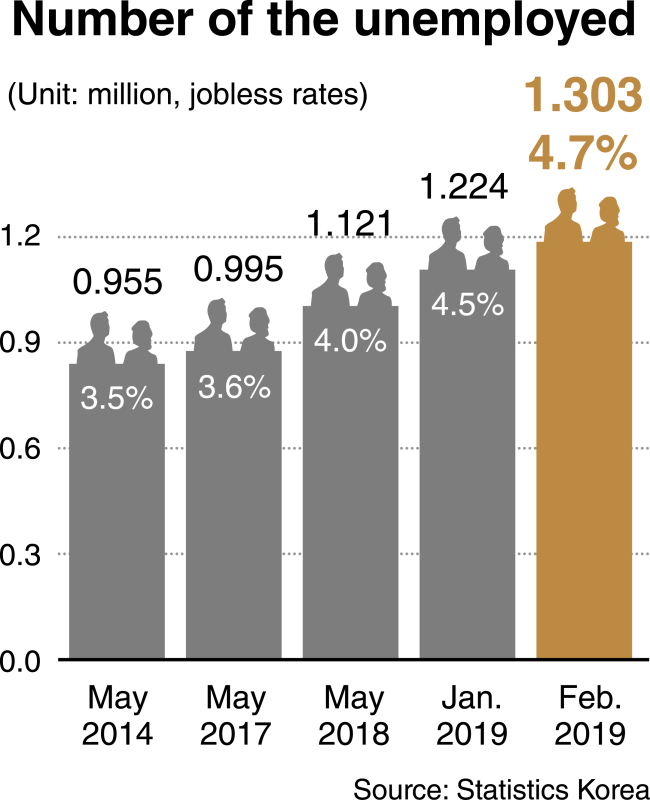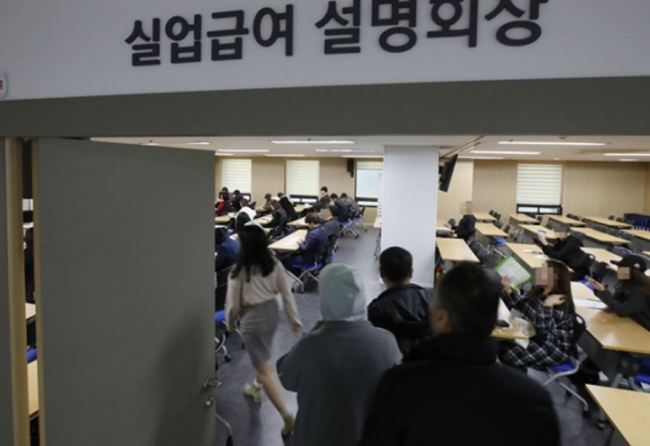[News Focus] Number of jobless Koreans grows 30.9% since May 2017
By Kim Yon-sePublished : April 4, 2019 - 17:42
The coming figures on the nation’s employment for March, which are to be unveiled mid-April, is drawing keen attention amid the seriousness of the recent job market, as recent data have showed.
South Korea saw the number of jobless people surge by 43.3 percent, or 394,000 individuals, over the previous three months -- from 909,000 in November 2018 to 1.303 million as of February 2019, according to Statistics Korea. The number continued to rise during the cited period -- 944,000 in December 2018 and 1.224 million in January 2019.
South Korea saw the number of jobless people surge by 43.3 percent, or 394,000 individuals, over the previous three months -- from 909,000 in November 2018 to 1.303 million as of February 2019, according to Statistics Korea. The number continued to rise during the cited period -- 944,000 in December 2018 and 1.224 million in January 2019.

Compared to the figure (995,000 individuals) for May 2017 when President Moon Jae-in took office, the number of unemployed is up 30.9 percent in 21 months.
Proportionately, the nation’s jobless rate climbed by 1.5 percentage points in the three-month period: 3.2 percent in November 2018, 3.4 percent in December, 4.5 percent in January 2019 and 4.7 percent in February.
By sex, the number of male and female unemployed came respectively to 720,000 and 584,000 as of February.
While the number of unemployed marked its highest in two years since peaking at 1.342 million in February 2017, some government officials have argued the increase “is attributable to active job-hunting of more elderly citizens, who are classified as ‘not economically active population.’”
Critics, however, say the argument is either unconvincing or illogical. “Government officials said the number of employed in their 60s or above increased by 397,000. This means younger generations suffered a sharp drop, on the contrary, in hiring amid the total increase in the number of jobless people,” said a research analyst in Yeouido, Seoul.
The analyst pointed out that job creation has been stagnant, under which the jobless rate among young generations simultaneously jumped, irrespective of seniors’ efforts to participate in the job market.

According to Statistics Korea, the number of jobless among those aged between 20 and 29 increased 14.5 percent over the corresponding period from 330,000 in November 2018 to 378,000 in February.
“(As the data shows) the number of the unemployed in their 20s increased by 48,000 in less than 100 days,” said the analyst.
The jobless rates among those aged 20-24 and those 25-29 posted 11.6 percent and 8.1 percent, respectively, for a combined 9.3 percent. By generation, the figure for those in their 20s marks the second-highest unemployment, right behind those aged 15-19, whose figure is 12.7 percent.
The figures for early 20s and late 20s are up from 9 percent and 7.6 percent (collectively 8.1 percent), posted a quarter earlier.
Further, the “sentiment-reflected” jobless rate among those 15-29 far surpasses government figures, hovering at 24.4 percent as of this year. The sentiment-reflected unemployment includes temporary employees with less than 36 hours of work a week who want to change jobs, and those out of work for certain periods despite eligibility when the surveys were conducted.
While the Ministry of Economy and Finance again cited a job-creation purpose for its plan to draft a coming supplementary budget, political heavyweights from opposition parties have already denounced the Moon government for its former extrabudgetary spending since taking office, raising questions as to the efficacy.
Liberty Korea Party Chairman Hwang Kyo-ahn said, “The incumbent administration is making (just) part-time jobs with taxpayers’ money,” labeling it incompetent.
He said the main opposition party “would closely look into the whereabouts of 54 trillion won (in taxpayer money, which had reportedly been allocated for job creation).”
It has been speculated that the Moon government has nominally poured about 54 trillion won ($47.5 billion) in taxes. That figure reportedly included the 2017-2018 ordinary budget worth about 36 trillion won, extra budget funds worth 15 trillion won and an employment-stabilization fund worth 3 trillion won into the job market, according to legislators.
By Kim Yon-se (kys@heraldcorp.com)
















![[KH Explains] Hyundai's full hybrid edge to pay off amid slow transition to pure EVs](http://res.heraldm.com/phpwas/restmb_idxmake.php?idx=652&simg=/content/image/2024/04/18/20240418050645_0.jpg&u=20240418181020)

![[Today’s K-pop] Zico drops snippet of collaboration with Jennie](http://res.heraldm.com/phpwas/restmb_idxmake.php?idx=642&simg=/content/image/2024/04/18/20240418050702_0.jpg&u=)